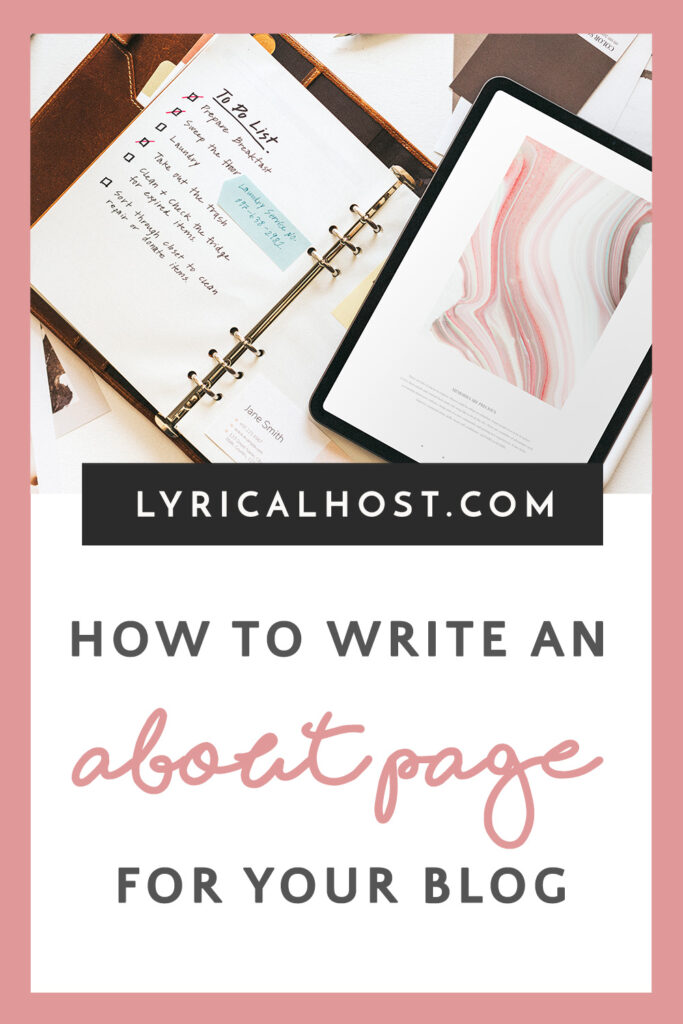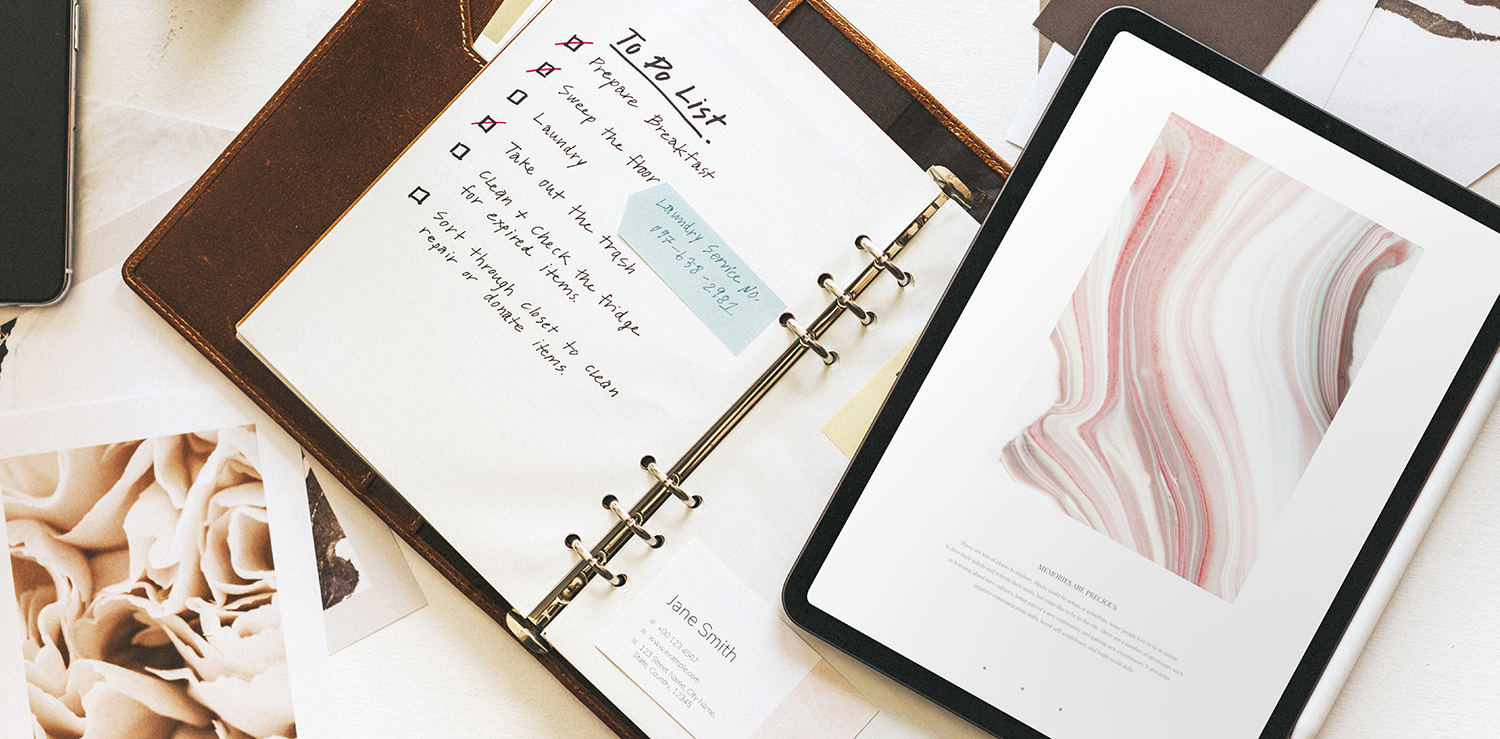About pages are often underrated; a lot of website owners see them as just another task on their to do list. However, it’s typically one of the most visited pages on any website, so it’s always a good idea to dedicate time and effort to it. Not only do you want to create a statement as soon you hit the publish button, but you also want to commit time to updating it to ensure it remains effective.
How To Create An Awesome “About” Page Share on X
Tip: Before you continue reading this post, make a note, task, or calendar reminder in your software of choice to update your About page. Ideally you want to be updating it at least once a year – it’s surprising how much changes in that time!
There are no right or wrong choices when it comes to what to include, but here are some things you may want to consider when you’re deciding how to approach your About page.
Words
Start with your origin story
How did you get to what you’re doing today? This could be in the form of a timeline, list, or as a mini autobiography. Where you start will depend on what’s relevant to your audience and your website; it may make sense to talk about your childhood if you’re a parent blogger or sleep coach, but maybe not otherwise!
If what you do is typically interpreted as boring by the general population, make it more fun by opening with an anecdote or something that adds a bit of human interest or nostalgia. For example, if you work in IT you could talk about your first computer or how you got into coding thanks to your mom.
Lean into personality
Even if the rest of your website is serious, people are looking for a personal aspect from your About page. If your blog is already personal, make sure your About page is consistent with your overall tone and doesn’t suddenly get formal because you’re referencing a media kit and links to publications without any context or descriptions.
Include something about you that your target customer/visitor will find interesting and useful. For example, if you’re a travel blogger, you could list your favorite places, or if you’re a nutritionist, your favorite healthy snacks. Very often, people are subconsciously thinking “what’s in it for me/what am I gaining from this?” when browsing content, so unexpected helpful value that also presents you as an authority is a win-win.
Highlight your passion
You may also want to incorporate something that shows your expertise and passion. For example, if you’re a photographer, you could talk about your kit (or link to a blog post that covers it in detail). If you’re a designer, you could list your favorite fonts and the reasons you love them. This may not be something your target customer/visitor fully appreciates in a lot of technical detail, but they’ll get the right impression – that you know what you’re talking about and you love what you do.
Skip the awkwardness
If you find it awkward talking about yourself, use other people’s words – ask a friend or client to provide a quote for you. Make it easier for them by providing a short prompt or topic, for example what you’re like to work with or what surprised them about you. Remember to give them a rough idea of how many words you’re looking for.
You could also use testimonials that mention your name, quotes from interviews, any media coverage you’ve had, or even blog comments where people have complimented you, your work, or your website.
Imagery
If your blog or website just features you, aim for a variety of contexts (for example one photo with a close up of your face, one photo a full body shot with an interesting background). You don’t have to have professional photos, but they should look considered – a photo of you alone in an interesting location works better than a group photo from a night out!
Your photos should be recognizably you; although it can be tempting to heavily edit them, use filters, or use ones from special events where you look different, people want to know that you’re authentic. They should be able to walk past you in the street and recognize you from your website photos.
If you work with people in any context and it’s relevant to your services, using imagery that reflects that is a huge advantage. For example, do you have any photos from when you’ve hosted a workshop or retreat, or worked one-to-one with a client? (If you don’t, consider planning a photo shoot). This helps visitors picture themselves in the same scenario with you, and also serves as social proof.
Video & audio
Whether you include video or audio is generally down to knowing your audience and what your own positioning is. For example, if you do talks, people may already recognize your voice and style, so continuing that on your website with an “About” video feels familiar and comforting to them because it’s more of the same. If they aren’t familiar with you, the reverse still works – the video serves as an introduction and then you’re more memorable in future if they attend your talk or listen to a podcast you’re guesting on.
Video and audio can also be a good way to capture a broader audience’s attention, and is also a bonus for accessibility. People have their own preferences for formats when it comes to consuming content, so the more options the better. It also provides opportunities for repurposing as you can use clips (or even the full version) on a variety of social media networks. Don’t forget to include subtitles/closed captions and/or a transcript.
Optional: Talking about your team
If you have a team, there’s a decision to be made about how they’re mentioned – or if they’re mentioned at all. There are pros and cons either way.
The advantages are that you get to celebrate the people you’re proud of, showcase your business growth, and show all the people involved in making your company a success.
The disadvantages are that it can be uncomfortable/intrusive for staff and become out of date quickly as team members leave or change. You’re also giving competitors and recruiters a handy list for poaching!
If you have an in-person team, a way around these issues is to have a single group photo, or a grid with photos of different team members in different contexts (e.g. helping people, at events, doing charity fundraisers) so that not every single individual needs to be listed separately.
Other options include only showing founders and/or the top level management team, or having a separate “Meet the Team” page which is subtly linked from your About page, but not a top level or main navigational feature on your website.
If you’re going down this route, go for real photos rather than avatars, which can look like stock. Some people like to do hover-overs or slow animations to show a serious, professional photo plus a fun photo with props or a crazy pose. For inspiration, take a look at SEO or web design agencies’ websites.
Tip: If you’re adding photos at different times as you grow your team, lightly edit the photos the same way so they look consistent. Aim for consistency in lighting and contrast in particular. A Lightroom Preset can often help with this if you’re coming back to photos years later.
Keeping the same format for each person’s description can help speed up the creating process and make it easier, for example:
- Their name and role
- What they’re passionate about
- Something they’ve been enjoying lately on their playlist or Netflix
- What they love most about their role, team or working environment
Keep the questions quite broad so that you don’t end up with a page of the same repeated answers (such as everyone saying that their favorite genre is horror).
Avoid the awkwardness of asking people to write their own bio by having other team members chip in with a line, for example:
- We appreciate/love working with/really value Lucy because she’s dedicated to helping new team members find their feet.
- Danielle surprised us at our summer party when we found out she trains circus hamsters.
Avoid generic phrases (“goes above and beyond”), sets team members in competition (“is always first to the buffet”) or anything that could be interpreted as condescending or downplaying their skills (“makes a great coffee”).
Progress, achievements and features
Create a timeline
Consider adding a list of milestones/landmarks to cover how your blog or business has evolved. If you’re starting out and it’s just you, list your own personal achievements and how (and why) you got to the point of creating your own website. This is a great way to break up your page and create easily skimmable content, plus you can do it from day one of starting your website.
List your features, collaborations and & awards
Your features and collaborations could be guest posts, guest podcast episodes, or physical publications. Maybe you’ve done some freelance writing or developed blog articles for a company you’ve worked for. Avoid mentioning dates so they feel more evergreen, and list the most well-known ones or ones you’re most proud of first.
Awards sections can be difficult as they can look out of date surprisingly quickly, especially when so much of the web works at breakneck speed. If you can, include the title of the award without the date, or use a photo (for example you attending an awards ceremony) rather than an award badge.
Side note: If you’re using logos or images provided by a company, remember to check that your use is allowed!
Look ahead
If you don’t have any awards and haven’t collaborated with anyone yet, how about listing your upcoming goals and plans? You could create a “40 under 40” style list, or link to a blog post on your future business plans (you can view our original one here: Our Story So Far (And Future Plans!))
About your blog or business
It’s up to you whether you want to create an entirely separate page for this or not. If you’re keeping your “about you” and your “about your site” content on the same page, it’s worth thinking about the ratio. If your website is a blog or people buy your services because of the person behind them, you may want to have a large proportion of the page content about you. If the service or products you provide are more important (e.g. people care about how long your business has been established or where your products are made), you probably want the opposite.
Not sure what to put? Here’s a quick checklist of some things you may want to incorporate:
- When and why you started your blog/business.
- Any causes you support, people you help, or ways you give back (see: Easy Ways To Give Back Through Your Blog Or Business – it doesn’t have to be things that cost money).
- Your ethics and morals where they relate to your business (e.g. how you offset carbon use or use local suppliers).
- Your tools of the trade. As you’ll get a good proportion of traffic to your About page and can dedicate a section to your website as well, it’s a great opportunity for affiliate links – including your Lyrical Host one of course!
Common questions
If it’s just me, should I use “I” or “we”?
It’s up to you – if it’s just you, it will be obvious to people when they start working with you so you may as well stick with that and be consistent from the outset! There are many people out there who specifically want to work with someone one-to-one rather than a team or feel like they have a personal, authentic connection with you through your blog, so it’s not a bad thing.
What if I don’t want to be public-facing?
Focus your About page is on your blog or business rather than yourself – you can still throw in interesting bits of information here and there. Ensure any photos of you aren’t super recognizable with clever angles or distance shots. For example, if you run a baking blog or classes, you could have an arty-looking overhead photo of your hands in a mixing bowl or rolling out shortbread cookies.
Some people have a strong opinion that you should always be very publicly-facing in your approach, but it’s not right for everyone and you can definitely make your page work without that.
Where can I see some examples of About pages?
Here are some About pages created by our customers for your inspiration:
https://yourtechwingwoman.com/about/
https://meanderingwild.com/about-meandering-wild/
https://tropicpianistgamer.co.uk/
https://www.lifeinabreakdown.com/who-am-i/
https://www.thepinkvelvetblog.com/about-the-pink-velvet-blog-and-niharika-verma
Bonus: fantastic inspiration from one of our customers at The Createry: https://www.yourweddingwingwoman.co.uk/about-us
Found this content useful? Pin the post for someone else to discover:







No Comments